In Adaptive Devices for Better Life, Students Collaborate to Help Others
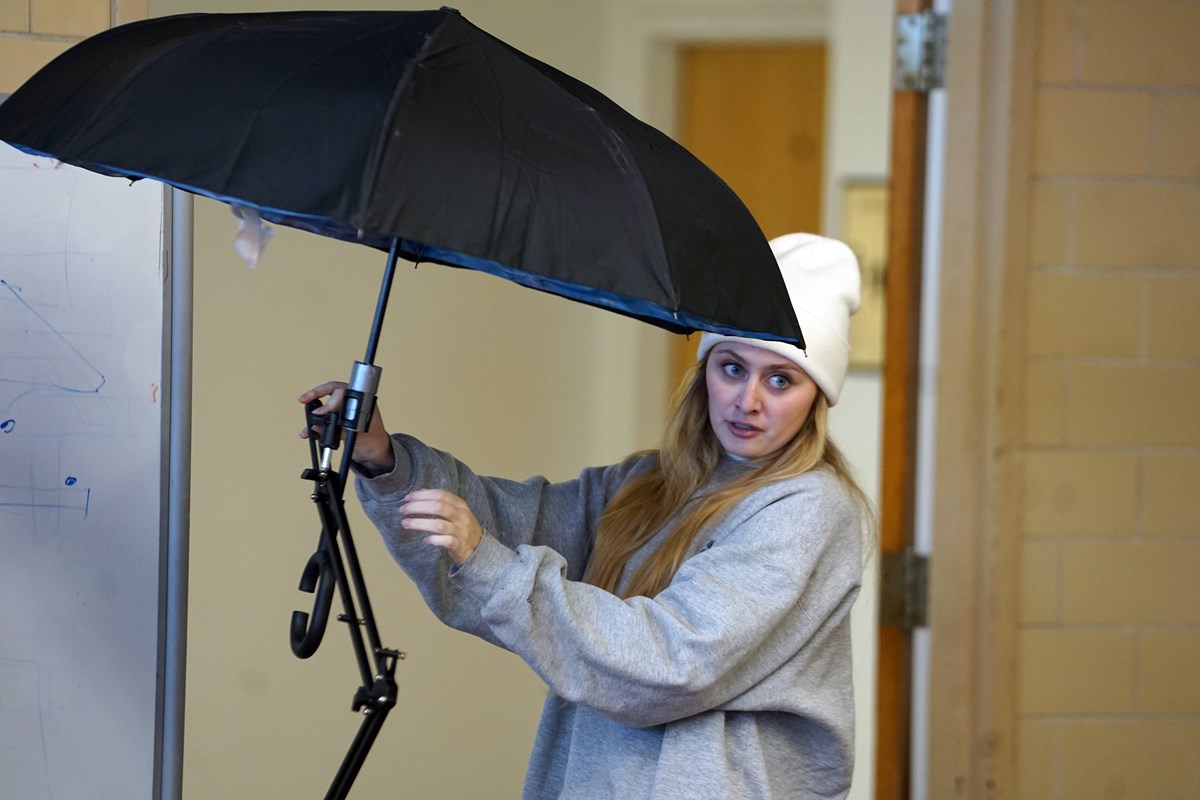 Image by Ed Brennen
Image by Ed Brennen
Alexis Sinotte, who completed her animation and interactive media degree in December, demonstrates Undercover, an umbrella attachment for walkers, wheelchairs and strollers that her team created in the Adaptive Devices for Better Life course last semester.
01/26/2024
By Ed Brennen
Mollie Chase’s arm slipped out of its shoulder socket as she sat and listened to students presenting their final projects in a course called Adaptive Devices for Better Life.
Chase, a math major from Haverhill, Massachusetts, has Ehlers-Danlos syndrome, a genetic disorder that weakens the connective tissue in joints.
“It just happens at rest. It will fall out again later,” said Chase, who discreetly popped her shoulder back in place while a team of fellow UML students presented a device that they had spent the semester creating for her — Bowl Tipper, a ceramic mixing bowl stand with a silicone insert to assist Chase while baking.
“Having something like this, where I can rest the bowl and turn it, will help me so much,” said a grateful Chase.
Offered for the first time last fall, Adaptive Devices for Better Life is an interdisciplinary course led by Assoc. Prof. of Art and Design Yuko Oda, Assoc. Prof. of Physical Therapy and Kinesiology Erika Lewis, and Asst. Prof. of Mechanical Engineering Kelilah Wolkowicz.
Divided into three teams, students worked with clients from the community who are living with disabilities. Each team invented a device, such as Bowl Tipper, that solves a problem for their client. The teams also entered their devices in the Rist DifferenceMaker Institute’s Francis College of Engineering Prototyping Competition.
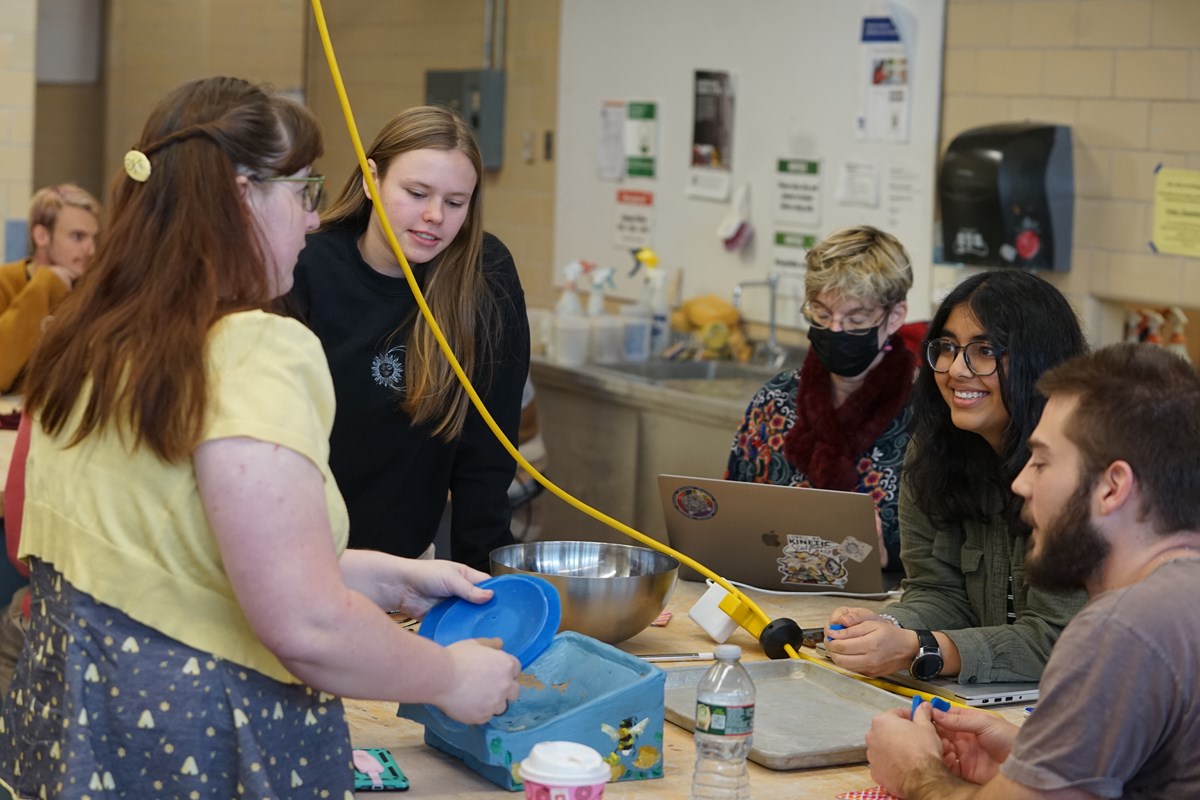 Image by Ed Brennen
Image by Ed Brennen
Math major Mollie Chase, left, discusses the Bowl Tipper device that students in the Adaptive Devices for Better Life course worked with her to create.
“With interdisciplinary synergy, we can achieve something that is not possible with just one discipline,” said Oda, who taught a similar course over a decade ago at the New York Institute of Technology.
At UML, Oda is working with Wolkowicz and Lewis on an interdisciplinary research project called Wheel Up, a wheelchair training simulator that integrates neuroscience, robotics, bioengineering, physical therapy and interactive media. They realized they were the ideal team to teach the Adaptive Devices for Better Life course, which fulfills an arts and humanities or STEM requirement, or an elective for a disability studies minor.
Jake Downes, a junior exercise science major from Winchester, Massachusetts, said the course confirmed his “calling” to help people in need.
“It’s one of the best classes I’ve taken. It’s a very hands-on class where you’re learning in a more creative environment,” said Downes, who was on the Bowl Tipper team with fellow exercise science major Haley Lewenczuk, studio art major Sam Poole and animation and interactive media major Dhruvi Patel.
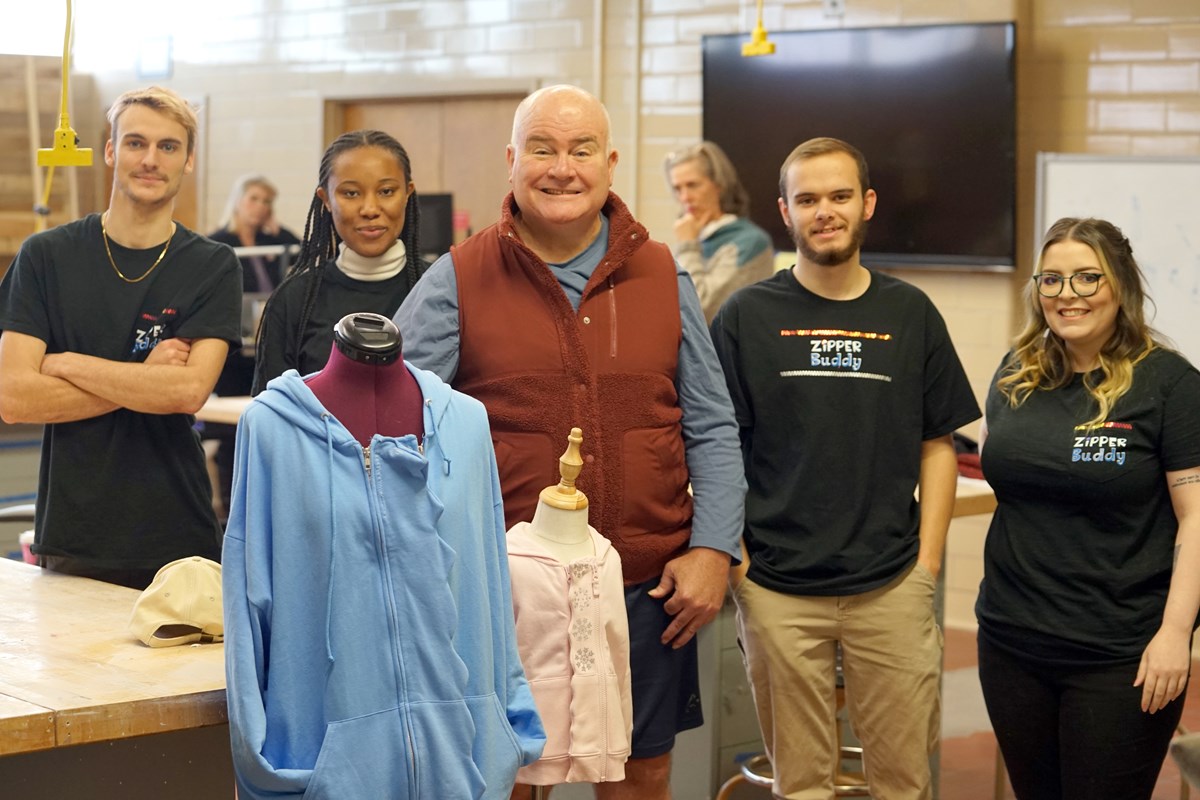 Image by Ed Brennen
Image by Ed Brennen
Business alum Bob Clancy '81, center, worked with the Zipper Buddy team of, from left, Haydn Hammill, Chibudom Azikiwe, Jason Lucier and Sandi DeRuntz on a clothing attachment that won the DifferenceMaker Francis College of Engineering Prototyping Competition.
Downes added that pitching the project to DifferenceMaker judges was “something that I didn’t expect to be getting from my college experience, but it’s something that will be great to show employers in the future.”
Another team, Zipper Buddies, won the $2,500 first prize at the Engineering Prototyping Competition and advanced to this spring's $50K Idea Challenge.
Sandi DeRuntz (studio art), Haydn Hammill (graphic design), Jason Lucier (biology) and Chibudom Azikiwe (biomedical engineering) worked with UML business alum Bob Clancy ’81, who has limited mobility on his left side due to a stroke. Together, they invented a fabric attachment that turns any zip-up garment into one that can be closed one-handed with Velcro.
“I was impressed from day one by the questions they asked and their ability to understand the challenges I have,” said Clancy, who lives in Chelmsford, Massachusetts. “From their compassion and caring nature, you can see they want to do well.”
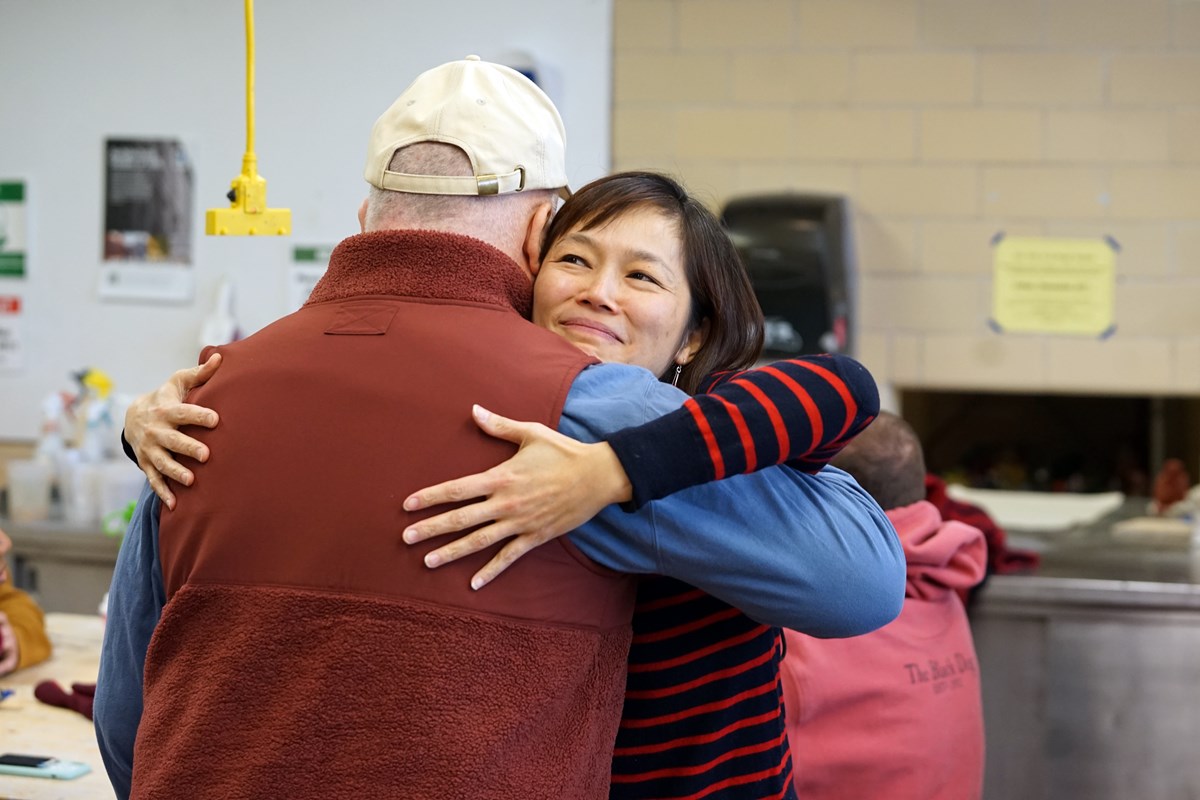 Image by Ed Brennen
Image by Ed Brennen
Assoc. Prof. of Art and Design Yuko Oda hugs Bob Clancy '81 following the students' final presentations.
DeRuntz also participated in the class as a client. She has lupus and sometimes uses a walker to get around campus.
To help her stay dry on rainy days, animation and interactive media majors Rachel Whipple, Alexis Sinotte and Shaynina Ribou and exercise science major Jack Downes created Undercover, an umbrella attachment for walkers, wheelchairs and strollers.
“It’s just amazing,” said DeRuntz, a Tyngsboro, Massachusetts, native who is minoring in disability studies. “So many times, I’ve explained to people what I go through, and they’re unable to grasp it. I’m so impressed by (the team’s) understanding.”
Whipple, a senior from Charlton, Massachusetts, took the course to satisfy a STEM requirement — and came away with something more.
“It allowed me to use my 3D modeling skills with Maya (software) for engineering, which is a different approach,” she said.
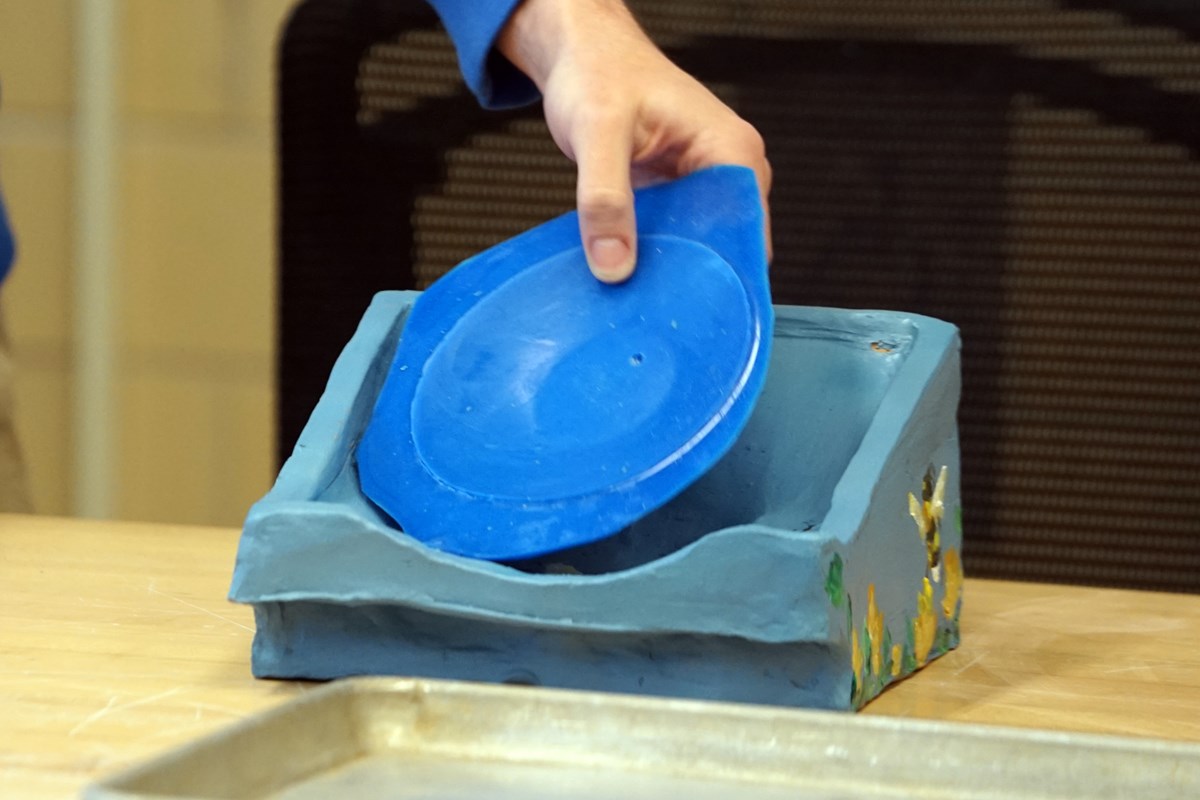 Image by Ed Brennen
Image by Ed Brennen
The Bowl Tipper, which math major Mollie Chase can use to hold mixing bowls while baking, features a silicone insert and is decorated with bright yellow bumblebees.
Sinotte, a native of Plaistow, New Hampshire, who completed her degree in December, said she developed her collaboration skills in the course, “which will help in the future if I’m working on a studio project.”
Art and Design Prof. Ellen Wetmore, who helped make the course a reality while serving as department chair, attended the teams’ final presentations. She encouraged students to bring a copy of their project folders on job interviews, as it “shows a high level of thought that a lot of other applicants can’t communicate.”
As the Bowl Tipper team showed Chase how she can use the device when baking, she noted that it was decorated with bright yellow bumblebees — one of her personal favorites.
“I love that they made something so unique and custom to my interests,” said Chase. “It doesn’t look medical; it’s not gray.”
“Making it personal to her was my favorite part,” said Poole, a senior from Nashua, New Hampshire, who appreciated the chance to work with students from other disciplines in the course.
“The art community is closely knit, so I don’t meet a lot of people from other sides of campus,” she said. “We were able to go above and beyond ideas with a wide range of people.”
